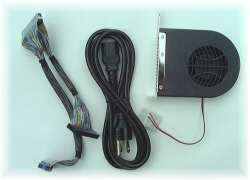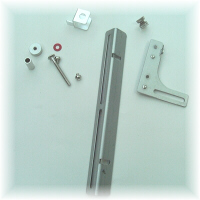Antec’s answer to the SFF community is a quiet, desktop cube case. Utilizing MicroATX form factor motherboards lets us choose our own upgrade path.
Introduction
In my never-ending quest for the perfect miniPC, which has been going on for a good 12 years, Antec has finally released their version of a SFF (small form factor) box. The Antec Aria is a microATX form factor PC case in the general shape of a cube. With this review, Ill look at the benefits of building your own SFF rig versus buying a similarly sized barebones system from the likes of Shuttle. I also want to address Antecs claim that the Aria is the quietest PC case in the entire world.” This is a tall claim that needs to be clarified.
Specifications
- Motherboards: The Aria accepts motherboards up to MicroATX (9.6″ x 9.6″), so youre basically looking at FlexATX, MicroATX, or even MiniITX boards.
- Expansion: Being a reasonably sized cube case, the Aria can accept 4 full-height PCI expansion cards. There is also room for up to three hard drives (more on this later) and one external 5.25-inch drive.
- Power Supply: Antec has included a proprietarily shaped 300 Watt power supply. This PSU uses one 120mm fan, venting out the back of the PSU. The 120mm fan moves a respectable amount of air at significantly lower noise levels (claimed 1200RPM, moving ~39 CFM at 25dB) than an 80mm unit moving a similar amount of air. This PSU also utilizes some circuitry to permit universal input, allowing the Aria to automatically accept line voltages from 100V to 240V AC.
- Card Reader: An 8-in-1 card reader is embedded in the front panel of the case. The card reader accepts all popular formats: CF I/II, MS, MS Pro, SM, SD®, MMC, MicroDrive®. The card reader requires an internal USB connection. A driver CD is included for the card reader.
- Front Panel Connections: On the front panel, there are ports for headphones, microphone, two USB ports and one Firewire port (IEE1394). All of these ports utilize pin connectors and are not pass-through connectors that must be routed out of the back of the case to be connected to external motherboard or add-in card ports.
- Size and Weight: Measures: 7.9″(H) x 10.6″(W) x 13.2″(D) [20 (H) x 26,9 (W) x 33,5 (D) cm] and Weighs: 10 lbs. (4.6 kg)
Packaging & Installation
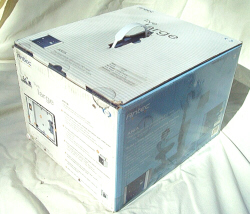 |
The Antec Aria arrives in a cardboard box that isnt much bigger than the case itself. It does have a handy, dandy carry handle on the top. |
|
Once removed from the Styrofoam packaging, the Aria is found completely assembled. Construction consists of aluminum with plastic outer panels on the top and front. The side panels are a strange mix of aluminum and plastic in almost three levels of thickness arrangement: aluminum-plastic-aluminum. The sides and top are aluminum colored while the front and trim is a deep navy blue. |
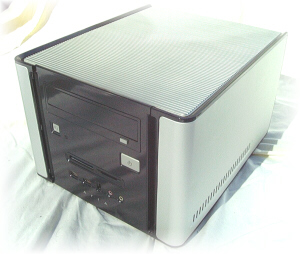 |
 |
The front of the case is simply, and therefore pleasingly, designed. There is an embedded drive cover for optical drives that is colored blue to match the case front. It can easily be removed. In my experience with cases that include these drive covers, the Aria is hands down the best quality cover Ive seen. It is built with thick plastic, ensuring that fumbling ham hands wont ruin its functionality during case tinkering. The large power button can be seen at right with the smaller reset button at left. Adjacent to the reset button is the blue HDD LED. Running up and down the outer edges of the blue section are angled cut-outs where two blue LEDS radiate up to permit the cut-outs to glow when powered on. The outer silver portions are actually part of the side panels. |
|
The side panels actually curve around to the front of the case. They are well-designed for easy removal via two screwless tabs at their back edge of the case. The top panel also easily lifts off the case, and it is held down via a single thumb screw. Therefore, access is quick and simple with the Aria. |
|
|
|
Beyond the case itself, Antec provides a rounded Cobra IDE cable (two would have been really nice), a power cord and a slot cooler (exhaust). I was originally very surprised to see the slot cooler, especially with Antec claiming that the Aria was the quietest PC case in the entire world. I thought, “Is this thing required for adequate cooling?” Its not really even discussed in the product specs. Any additional fans are only going to add noise, and a slot cooler isnt the best solution for desktop, cube cases when add-in cards are used. Using one in this case only really vents some air from the adjacent add-in card. In the end, I chose not to use this slot cooler since I was using a few add-in cards. If I had no such cards and that area of the case was open to the CPU, I would have used it. |
|
|
Also included in the extra material is this stuff. Tell me if you know what this stuff is. Like any other normal, young American male, I hadnt even cracked the cover of the included paperback manual. The manual is reasonably well appointed but there are few pictures and none depicting these metal bits. After reading the book more thoroughly, I determined the aluminum brackets must be a part of an 80mm CPU fan mounting system, if you choose to use this. I suppose this could be a solution for those who would like to try and shoe horn a passive Zalman into this case, just to find out its inadequate and then need to append a suspended fan. |
|
Finally opening the case, heres a look at the card reader spaghetti. The cabling is nicely wrapped in plastic sheaths. The only problem here is that there are so many of the little buggers. Theres one for the USB ports, one for the Mic, one for the headphones, one for the firewire, and one for card reader itself. It can get sloppy. |
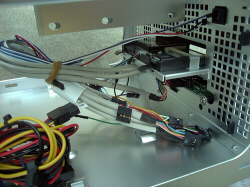 |
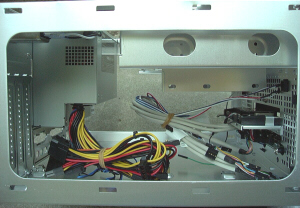 |
Heres a full view of the left opening. The oddly stepped-shaped power supply can bee seen at the left. The removable drive cage is still in place. |
|
The drive cage has a rather ingenious mounting system. Two metal sleeves guide the cage in and out along two slots in the sides of the case. There are no screws to secure the cage. The two rubber feet at the top are intended to provide enough resistance to hold the cage in place, once they rest against the top of the case when its installed. |
 |
|
|
The cage, itself does permit the use of up to three hard drives. I was very curious as to how Antec would make this work when I first saw the 3 HDD support in their specifications list. How it works is that one hard drive is mounted horizontally below the CD-ROM and then two additional HDDs can straddle the center mounted drives, mounted vertically. The picture at left is looking at the cage upside and from the rear, for your reference, and it shows how a second hard drive would be mounted. Unfortunately, you can forget using three HDs if you use an AGP card and perhaps even something in the first PCI slot. The HDD slot on the left side of the cage causes the hard drive to hang low in the area of the AGP/first PCI slot. |
|
In an added attempt to reduce noise and reduce heat, Antec has included these HDD mounting bolts which have rubber grommets on them to dampen the drives. The mounting edges of the hard drives on the cage are also lined with a thin thermal tape that should help dissipate heat and help in the noise dampening. |
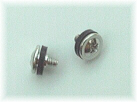 |
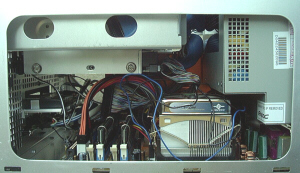 |
Ive actually built two systems using the Aria already. This picture is of the right side of my system, which was the first that I built. Installing the motherboard in this system was a chore with the power supply left in place. I had trouble getting the back I/O panel to clear the bottom edge of the power supply. In the second system that I built, I removed the PSU first, and I highly recommend this for Aria purchasers. Also, try to mount up as many of the motherboard connections as possible before installing the motherboard. |
|
Looking into the left side of my built system, you can see the spaghetti. There is really limited space to clean up the wiring much better, especially when add-in cards are used. I have a MSI GeForce4 Ti4600 installed here. There really was zero problems installing the video card in this case. I wish I could say the same for many SFF barebones systems. There is also a Hercules Digifire 7.1 sound card installed. The ribbon cable extending from the sound card is the game port which requires a separate slot. |
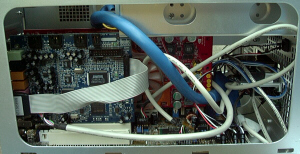 |
MicroATX vs. SFF System
Ive been a long proponent of MicroATX-based systems. As time goes on, were seeing better and better chipsets being released in this smaller form factor and more quickly then they used to be. However, for the overclockers out there, few MicroATX motherboards offer much overclocking potential. This doesnt concern me personally since CPU power is relatively cheap. Beyond this, there are many advantages to building a small MicroATX rig instead of buying a SFF system:
- Cost: A good SFF barebones system will cost you $250-300 while you can build a similar barebones setup, using a MicroATX motherboard and the Aria, for $50-100 less. The extra money could go towards better peripherals (larger hard drive, a video card, more RAM, etc.).
- Size: Besides the Aria, which is slightly larger than your typical SFF system, there is an ever increasing number of very reasonably priced and very small MicroATX cases out there. If you dont need expansion slots, you could build a system considerably smaller than most SFF systems. Many of which, including the Aria, are intended for system builders to compete with the SFF market. The Aria is actually near the top of the price range for MicroATX cases at $99 ESP.
- Variety: Coupled with the choices of cases, you have the choice of motherboards with the features that you want. You may not find many, if any, MicroATX motherboards with RAID controllers onboard, but youll find many with 4 USB2.0 ports out the back, support for the latest CPUs (including 64-bit models), SATA, and more.
Your creativity and ingenuity is the only limit to what you can assemble for yourself in a MicroATX system. The system that Ive assembled for the Antec Aria includes the following:
- Motherboard: Asus P4P800-VM (Intel 865G, DDR400, SATA, 8 USB2.0, P4 Hyperthreading support)
- CPU: Intel P4 2.8E Prescott
- Memory: 1GB Corsair XMS PC3200
- Cooler: Vantec Aeroflow
- Hard Drive: Maxtor 160GB EIDE 8MB Cache
- CD-ROM: Lite-On 16xDVD/48xCD-RW combo
- Audio: Hercules Digifire 7.1 PCI
- Video: MSI GeForce4 Ti4600 AGP8x
- OS: Windows XP Pro
Thoughts and Conclusions
First, lets talk about Antecs claim that this is the quietest PC in the world. Firstly, that is flat out an impossible claim, because it is not a complete system as shipped by the manufacturer. Every Aria user is going to have to install many other parts into the Aria in order to get a working PC, and the ultimate quietness of the system is going to depend on what components are selected. Certainly, I could have purchased a fanless, VIA Eden platform and used a Microdrive for my data storage, creating a very quiet system. But most users arent going to be doing that. And, to be perfectly honest, Ive yet to play with a modern SFF computer that was quieter than ECSs EZ Buddie, which uses an external power supply. I just dont think Antec should have been so bold as to make such a claim for this type of product. My system in the Aria is actually quite loud. The Vantec Aeroflow is a rather noisy cooler. Now that it is on my desktop, and Im forced to listen to it drone all day, Im already shopping for something else that will fit. Which brings up another important note: Be careful of what motherboard and heatsink combination you choose for this case. As you can see above in the picture that shows my heatsink, there is a reasonable amount of space between my CPU heatsink and the power supply, but this may not be the case for every available motherboard.
In the end, Im actually very pleased with the appearance and performance of the Antec Aria. Other than my minor jibes about the fan bracket and tight fit of the motherboard when the power supply is installed, the Aria is likely the best built and best designed MicroATX cube case that Ive used (and this is far from my first foray into MicroATX cubes).
With its compact size while still having room enough to be a very effective platform base, Im awarding the Antec Aria MicroATX Cube Case a score of 8 out of 10 and the Bjorn3D Seal of Approval.
 Bjorn3D.com Bjorn3d.com – Satisfying Your Daily Tech Cravings Since 1996
Bjorn3D.com Bjorn3d.com – Satisfying Your Daily Tech Cravings Since 1996
